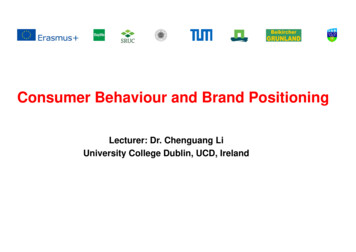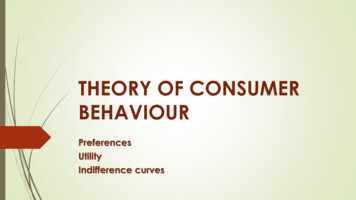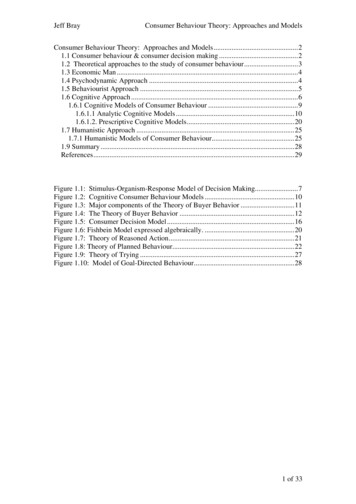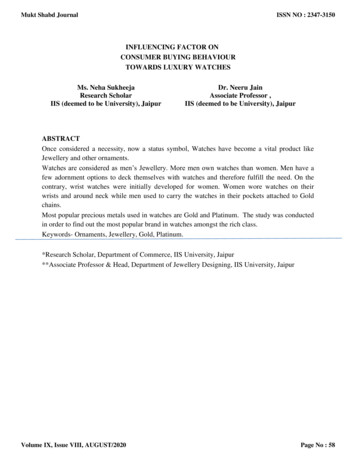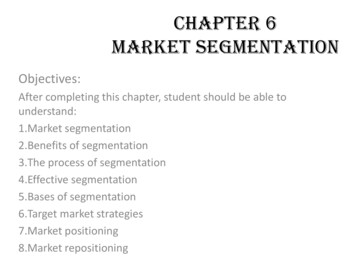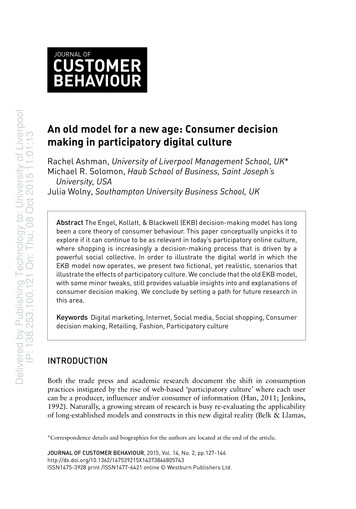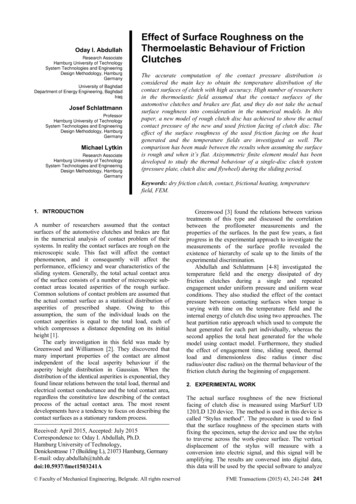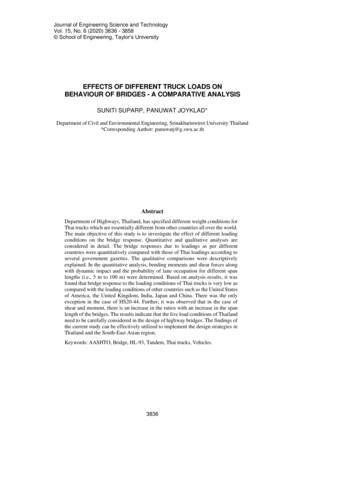
Transcription
Understanding consumer behaviour“There is only one boss – the customer. And he canfire everyone from the Chairman down”Sam Walton, Founder, WalMart Stores1
What is consumer behaviour? Consumer behavior: the study of the processes involvedwhen individuals or groups select, purchase, use, or disposeof products, services, ideas, or experiences to satisfy needsand desires (Solomon,2006)2
What is consumer behaviour? “The decision process and physical activity individuals engagein when evaluating, acquiring, using or disposing of goodsand services”Loudon and Della Bitta “Those acts of individuals directly involved in obtaining,using, and disposing of economic goods and services,including the decision processes that precede and determinethese acts”JF Engel3
Definition of consumer A consumer is a person who identifies a need or desire, makes apurchase, and then disposes of the product (Solomon, 2006)4
Studying consumer behaviour5Blackwell 2006
Comprehensive models of consumer behaviour(Blackwell 2005)6
Marketers response to decision makingstagesStage in decisionprocessMarketing strategyExampleProblem recognitionEncourage consumers to see that existing does notmatch desiredCreate TV commercial showing excitement ofowning new carInformation searchProvide information when and where consumers arelikely to searchAdvertising slots with high target marketviewershipNew car brochures for dealersExciting easy to navigate websitesAlternative evaluationUnderstand how consumers compare brands andcommunicate own brand superiorityResearch most important choice criteriaCreate advertising to communicatesuperiority on key choice criteriaProduct choice/purchaseUnderstand how consumers choose (choice heuristics)and provide communications that encourage branddecision“Swiss made” , “Vorsprung durch technik “(Country of origin)Long history of the brandRecommended by expertsPost purchase evaluationCreate consumer expectationsProvide “scientific evidence”Based on Solomon 20107
Common features of consumer behaviourmodels Consumer behaviour as a decision process Behaviour is rational and can be explained Behaviour is purposive involving search, evaluation andstoring of data Preferences develop based on more limited use ofinformation Outcomes from purchase decisions, whether satisfaction ordissonance shape future purchase decisions8
Who is the consumer?9ROLEInitiatorDESCRIPTIONInfluencerA person who intentionally, or unintentionallyinfluences the purchase decision , the actualpurchase and/or the use of the product or serviceBuyerThe individual who makes the purchasetransactionUserThe person most directly involved in theconsumption of the purchaseIndividual who determines that some need or want isnot being met and initiates purchase behaviour torectify the situation
Why study consumer behaviour “Marketing management rests upon some conception orother of how customers behave and of the consequences theirreactions to product, price, promotion and distributionstrategies are likely to have for the attainment of corporateobjectives. In affluent competitive economies successfulmarketing depends above all on matching the marketing mixwhich results from the integration of these strategies to thewillingness of consumers to buy and in doing so moreeffectively than one’s rivals”(Gordon Foxhall)10
How do consumers approach retailpurchases? “Generally speaking human beings are usually quite rationaland make systematic use of the information available to them.We do not subscribe to the view that human social behaviouris controlled by unconscious motives or overpoweringdesires, rather people consider the implications of theiractions before they decide to engage or not engage in a givenbehaviour”Ajzen and Fishbein (1980)11
The information processing consumerand rational shopping behaviourCONSUMERRECEIVING - perceptionsINTERPRETING – experiences, goals, aspirations, statusSEARCHING – clarification of aroused need/wantEVALUATING – alternative options for need satisfactionDEVELOPING – beliefs, attitudes, opinions repurchase intentionACTING – translate to behavioural intentionRE-EVALUATING – extent of satisfaction12STORE – outputs, attitudes for future reference
One more time – how do consumersapproach retail purchases? “A true understanding of shoppers’ decision makingprocesses is the key to retail success. Psychologists haveidentified that we have two main shopping modes: alpha andbeta. In the alpha state, attention is fully engaged and thedecision process is conscious. But 80% of our shopping iscarried out in beta mode.(when).all decision making,orientation and interaction is subconsciouslycontrolled.”Siemon Scamell-Katz (2002)13
Types of buying situation in consumermarkets EXTENDED PROBLEMSOLVING LIMITED PROBLEMSOLVING HABITUAL PROBLEMSOLVING14 Lengthy information searchand close examination ofalternatives Reduced search andevaluation based on priorknowledge ofproduct/market Repeat purchase with little orno evaluation
Marketing mix determination andconsumer behaviour PRODUCT PRICE Size, shape, features, design, packaging,service, warranties Price awareness, brand/price sensitivity, priceelasticity of demand, incentive to encourageadoption PLACE PROMOTION15 Distribution channels, retail outlet, retailimage How to promote, gain attention,communicate message, encourage trial,encourage repurchase, build loyalty, purchaseinfluences
Satisfaction and dissatisfaction Critical concept in marketing Satisfaction more likely to lead to repeat purchase/loyaltyand positive WOM Dissatisfaction more likely to lead to brand switching,complaints and negative WOM Expectancy disconfirmation with performance approach(Oliver 1997) and the Balancing Paradigm (Fournier andMick 1999) are two current theories of consumer satisfaction16
The Expectancy Disconfirmation model(from Peter and Olson based on Oliver 1997) ve disconfirmation : PPP PPE satisfaction-ve disconfirmation: PPE PPP Satisfaction/dissatisfaction17
Consumer value equation Perceived value (PV) Perceived benefits (PB)Perceived costs (PC)Benefits attributes of core product/service and supporting services,perceived quality and priceCosts customer costs involved in purchasing, such as time, travel,repairing faulty work, etc. – NOT just price18
Summary: how marketers can useconsumer insight Focus on factors that determine consumer perception ofvalue (maximise perception of benefits/minimise perceptionof costs/minimise perception of risk) Consumers make purchase decisions to solve problems andreduce dissonance (store choice and product choice).Marketing activities should aid consumer decision making. Purchase behaviour is driven by multiple motives and themarketing offer should deliver multiple sources ofsatisfaction19
Week 1: Key termsConsumer behaviourConsumer centricmarketingProblem/need recognitionInformation searchEvaluation of alternativesPost purchase evaluationExtended problem solvingLimited problem solvingHabitual problem solvingConsumer insightInitiatorInfluencerBuyerRational purchase decisionSatisfaction, dissatisfaction20
Understanding consumer behaviour 1 . What is consumer behaviour? Consumer behavior: the study of the processes involved when individuals or groups select, purchase, use, or dispose of products, services, ideas, or experiences to satisfy needs and desires (Solomon,2006) 2 . What is consumer behaviour? “The decision process and physical activity individuals engage in when evaluating,

